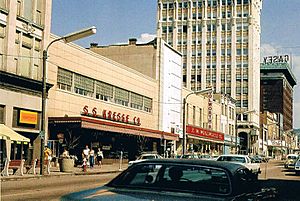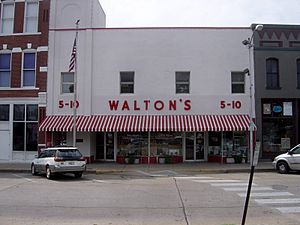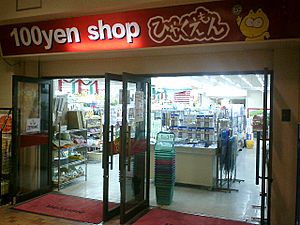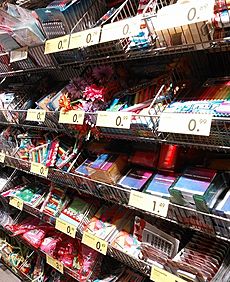Variety store facts for kids
A variety store is a type of shop that sells many different kinds of products. These can include clothes, toys, tools, and even some food items. Often, these stores sell items at lower prices than other shops. Sometimes, everything in the store costs just one price, like a dollar or a pound. Historically, they were known as "five and dime" stores because items cost five or ten cents. These stores are different from big supermarkets or large department stores.


How Variety Stores Work
Making a Profit
Variety stores make money in a few ways. They often buy huge amounts of goods at very low prices. Even if they sell these items for only a little more, they make a profit because they sell so many.
Sometimes, they sell items for more than you might find at a regular store. Customers might think these are good deals because other items in the store are heavily discounted. For stores where everything is one price, they might sell smaller packages of items to make a profit.
Where Products Come From
Many products in variety stores come from other countries. This is because it can be cheaper to make things where wages or taxes are lower. These goods are usually bought by a large importer and then sold to the stores.
Another source for products is leftover items or goods that are no longer popular. Sometimes, they even sell food products that are close to their "sell-by" date. The rules for selling these items can be different in various places.
Variety Stores Around the World
North America
In North America, variety stores are very popular. They have grown a lot since 1998 and are now a huge industry. Often, when other types of stores close, dollar stores open in their place. They do well because people often buy things on impulse when they see a good deal.
Five and Dime Stores

The idea of "five and dime" stores started with Frank Winfield Woolworth. He saw how successful "nickel stores" were, where everything cost five cents. In 1879, he opened his "Great Five Cent Store." His success led to many "five and ten cent stores," also called "five and dimes."
Before Woolworth, people thought a store couldn't survive selling only low-priced goods. But his success proved them wrong, and many others followed. Famous five and dime stores included F. W. Woolworth Company and S. S. Kresge Co. (which became Kmart). Walton's Five and Dime later became Walmart.
Over time, these older variety stores faced competition from larger "discount stores" and malls. Many of them closed down by the late 1990s.
Dollar Stores Today

Starting in the late 1990s, dollar stores became very popular. They were liked for their low prices and because they were often easy to reach in small towns and neighborhoods. By 2019, chains like Dollar Tree had huge sales, even more than some big department stores.
Major dollar store chains in the U.S. include Dollar General, Dollar Tree (which also owns Family Dollar), and Five Below. These chains continue to open many new locations across the country.
Names for Variety Stores in North America
- Dollar store (most common, even if items cost more than a dollar)
- Dime store
- Five and Dime
- Five and Ten
- 5 y 10 (in Mexico)
Oceania
In Australia, popular variety stores include The Reject Shop and Daiso. In New Zealand, you might find "The $2 Shop."
Names for Variety Stores in Oceania
- The $2 shop (in Australia and New Zealand)
- Cheap Shop (in Australia)
Asia
In Japan, "100-yen shops" (hyaku-en shoppu) became very common around 2001. This happened after a long period of slow economic growth. A big chain of 100-yen shops is Daiso, which has thousands of stores in Japan and has expanded to other countries.
In China, you can find ¥2 or ¥3 shops. In Hong Kong, there are "$10 shops" (about US$1.28) and even "$2 shops" (about US$0.26). These low prices are helped by Hong Kong not having a sales tax and being close to China.
In India, the US Dollar Store started in 2003. They now import products from many countries to keep costs low.
Names for Variety Stores in Asia
- 100-yen shop (in Japan)
- 10-dollar shop (in Hong Kong)
- 1000 Won shop (in South Korea)
- 49 & 99 shop (in India)
- 2-ringgit stores (in Malaysia)
Europe
In Europe, variety stores are also very common. In Germany, you can find "ToBi" stores, meaning "Totally Inexpensive," where most items cost one or two Euro or less. Chains like Action, HEMA, and TEDi are popular across many European countries.
In the Netherlands, the HEMA chain started by selling goods at fixed prices like 10, 25, or 50 cents. After World War II, they stopped this system, but HEMA is still a very large chain.
In Spain, stores were once called "Todo a 100" ("everything for 100 pesetas" which was about €0.60). Now, most items cost more, but the name is still used to mean something is cheap.
In the United Kingdom, Woolworth's opened in 1909. Today, modern variety stores include Poundland and Home Bargains.
Names for Variety Stores in Europe
- Euro store, €2 store (in the Eurozone)
- Pound shop, 99p shop (in the United Kingdom)
- 100 forintos bolt (in Hungary)
- Todo a 100 (in Spain)
South America
In Argentina, variety stores are called todo por dos pesos (everything for 2 pesos). In Chile, they are called todo a mil (referring to the one thousand Chilean pesos banknote).
Names for Variety Stores in South America
Africa
In Egypt, a variety store might be called a £E2.5 shop.
Global Chains
Miniso is a Chinese variety store chain that sells many household items, cosmetics, toys, and kitchenware. It has grown very quickly and now has over 1,800 stores in Asia, Europe, Oceania, Africa, North America, and South America.
See also
 In Spanish: Tienda de todo a 100 para niños
In Spanish: Tienda de todo a 100 para niños
- Marketing
- Types of retail outlets
- 100-yen shop





